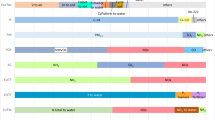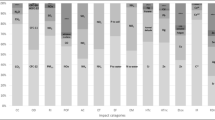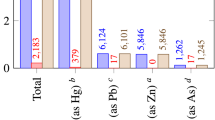Abstract
Purpose
In life cycle impact assessment, normalization can be a very effective tool for the life cycle assessment practitioner to interpret results and put them into perspective. The paper presents normalization references for the recently developed USEtox™ model, which aims at calculating globally applicable characterization factors. Normalization references for Europe and North America are determined, and guidance for expansions to other geographical regions is provided.
Materials and methods
The base years of the European and North American inventories are 2004 and 2002/2008, respectively. Emission data were extracted from two literature sources referring to each of the considered regions. The inventory for North America was adapted to avoid extrapolation of data from other regions and thus bring consistency with the emission inventory for Europe. In spite of different inventory assumptions, a similar coverage of substances was obtained for both regions with relatively high representation of metals and a number of organic compounds, mainly consisting of non-methane volatile organic compounds and pesticides. The two inventory sets were eventually characterized with the characterization factors (CFs) calculated with the version 1.0 of the USEtox™ model and substance database; both interim and recommended CFs were used.
Results and discussion
Normalization references are provided for Europe and North America for the three USEtox™ toxic impact categories; ratios between the normalization references for the two regions in all cases lie below a factor of 3. Causes for the observed discrepancies are found to be different inventory assumptions as well as variations in the type and intensity of actual emissions between the two regions. Additional causes are inventories that only cover a limited number of substances, and the characterization model, which can only provide interim factors for certain substances like metal compounds. Based on these causes and on a review of recent studies on normalization references, a list of substances to be prioritized when collecting emission data was built, demonstrating the importance of metals.
Conclusions
In the perspective of further refining the presented normalization references and of calculating new references for other regions, guidance is provided including a list of priority substances that should be considered when building emission inventories for normalization references.
Similar content being viewed by others
Notes
Although neglected here, certain salt lakes are endorheic basins with no outflow of water except evaporation, hence incompatible with the inventory analysis behind the calculated normalization references; because of limited data availability on the proportions of such cases in the total lake basins, this incompatibility was, however, disregarded.
References
Bare J, Gloria T, Norris G (2006) Development of the method and US normalization database for life cycle impact assessment and sustainability metrics. Environ Sci Technol 40(16):5108–5115
Birkved M, Hauschild MZ (2006) PestLCI-A model for estimating field emissions of pesticides in agricultural LCA. Ecol Model 198(3–4):433–451
Ecoinvent Centre (2007) Ecoinvent Data. Swiss Centre for Life Cycle Inventories. Dübendorf. Switzerland. www.ecoinvent.ch
Ferlay J, Shin HR, Bray F et al. (2010) GLOBOCAN 2008, Cancer Incidence and Mortality Worldwide: IARC CancerBase No. 10 [Internet]. International Agency for Research on Cancer. Lyon, France. http://globocan.iarc.fr
Guinée JB, Gorrée M, Heijungs R, Huppes G, Kleijn R, Koning Ad, Oers Lv, Wegener Sleeswijk A, Suh S, De Haes Udo HA, Bruijn Hd, Duin Rv, Huijbregts MAJ (2002) Handbook on life cycle assessment. Operational guide to the ISO standards. I: LCA in perspective. IIa: Guide. IIb: Operational annex. III: Scientific background. Kluwer, Dordrecht
Hellweg S, Demou E, Bruzzi R, Meijer A, Rosenbaum RK, Huijbregts MAJ, McKone TE (2009) Integrating human indoor air pollutant exposure within life cycle impact assessment. Environ Sci Technol 43(6):1670–1679
IARC (2008) World Cancer Report 2008 [Boyle P, Levin B (ed.)]. International Agency for Research on Cancer (IARC). Lyon, France
ISO (2006) ISO 14044 International Standard. In: Environmental Management – Life Cycle Assessment – Requirements and Guidelines
Kiely T, Donaldson D, Grube A (2004) Pesticides Industry Sales and Usage – 2000 and 2001 Market Estimates. In: US Environmental Protection Agency, editor. Biological and Economic Analysis Division Office of Pesticide Programs Office of Prevention, Pesticides, and Toxic Substances. Washington, DC
Laurent A, Olsen SI, Hauschild MZ (2011) Normalization in EDIP97 and EDIP2003: updated European inventory for 2004 and guidance towards a consistent use in practice. Submitted for publication in The International Journal of Life Cycle Assessment, November 2010. doi:10.1007/s11367-011-0278-6
Lautier A, Rosenbaum RK, Margni M, Bare J, Roy P, Deschênes L (2010) Development of normalization factors for Canada and the United States and comparison with European factors. Sci Total Environ 409(1):33–42
Lundie S, Huijbregts MAJ, Rowley HV, Mohr NJ, Feitz AJ (2007) Australian characterisation factors and normalisation figures for human toxicity and ecotoxicity. J Clean Prod 15(8–9):819–832
OSPAR Commission (2006) Data Report on the Comprehensive Study of Riverine Inputs and Direct Discharges (RID) in 2004 (incl. addendum for France and Ireland)
Rosenbaum RK, Bachmann TM, Gold LS, Huijbregts MAJ, Jolliet O, Juraske R, Koehler A, Larsen HF, MacLeod M, Margni M, McKone TE, Payet J, Schuhmacher M, Dvd M, Hauschild MZ (2008) USEtox—the UNEP-SETAC toxicity model: recommended characterisation factors for human toxicity and freshwater ecotoxicity in life cycle impact assessment. Int J Life Cycle Assess 13(7):532–546
Shiklomanov IA, Rodda JC (2003) World Water Resources at the Beginning of the 21st Century. Cambridge University Press, Cambridge. ISBN 0-521-82085-5
Sleeswijk AW, Huijbregts MAJ, van Oers LFCM, Guinée JB, Struijs J (2008) Normalisation in product life cycle assessment: An LCA of the global and European economic systems in the year 2000. Sci Total Environ 390(1):227–240
Wenzel H, Hauschild M, Alting L (1997) Environmental Assessment of Products: Volume 1—Methodology, Tools and Case Studies in Product Development. Chapman & Hall, London
Author information
Authors and Affiliations
Corresponding author
Electronic supplementary materials
Below is the link to the electronic supplementary material.
ESM 1
(XLS 67 kb)
Rights and permissions
About this article
Cite this article
Laurent, A., Lautier, A., Rosenbaum, R.K. et al. Normalization references for Europe and North America for application with USEtox™ characterization factors. Int J Life Cycle Assess 16, 728–738 (2011). https://doi.org/10.1007/s11367-011-0285-7
Received:
Accepted:
Published:
Issue Date:
DOI: https://doi.org/10.1007/s11367-011-0285-7




